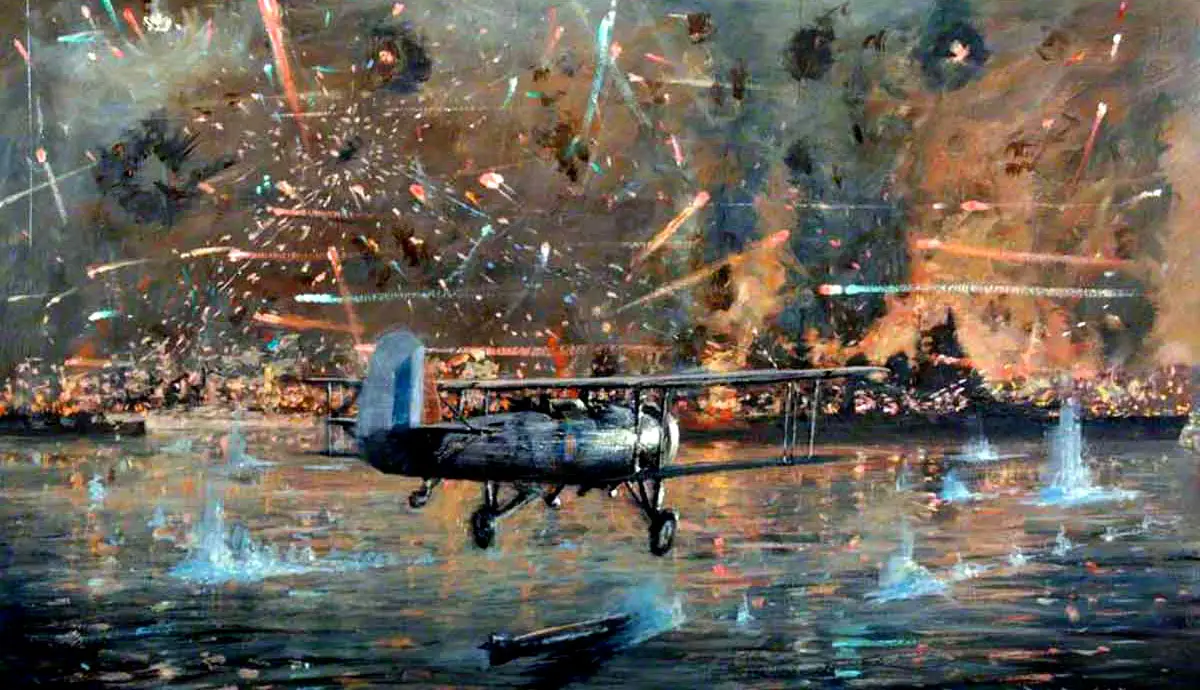How WWI-era Biplanes Ended the Reign of Battleships
Published: 27 March 2023
By Allen Frazier
via TheCollector web site

A Fairey Swordfish Launching a Torpedo Against Italian Ships at Taranto
By World War I, most navies centered their power around massive battleships. However, the recent introduction of biplanes to warfare would change that.
In the years leading up to World War I, aviation became an increasingly fascinating field for military planners. As the guns of Europe began raining shells down upon the land, military officials quickly militarized planes as reconnaissance tools. Soon, biplanes were armed with machine guns for defense and bombs for offense, creating a new field of warfare. Meanwhile, the navies of the world, mostly armed with massive dreadnaughts as a sign of strength, continued operations as they had for centuries. Unbeknownst to the warring nations, aviation and aircraft carriers would soon halt the mighty battleship as the true sign of strength on the high seas. While most think of Pearl Harbor in 1941 as the first event to highlight the shift from battleships to carriers, another event 13 months prior foreshadowed the disaster in Hawaii.
World War I Biplanes & Naval Warfare

A Depiction of Air Combat Between WWI Biplanes, via Military History Now
The airplanes of World War I were slow and made of soft materials, though they proved invaluable in turning the tide of war. Initially, planes were outfitted with cameras and used as tools to survey the scene beyond the trenches. However, pilots began carrying pistols and grenades for self-defense. Eventually, some planes were outfitted with small projectiles or bombs to attack ground targets.
The invention of an interrupting mechanism allowed forward-firing machine guns to shoot past propellor blades without damaging them. While rare and somewhat ineffective initially, an increasing arsenal of planes on both sides eventually culminated in massive aerial dogfights. While still archaic to today’s standards, these biplanes of World War I had yet to prove their full potential, even as the pilots earned unparalleled fame.
On the high seas, steel dreadnaughts combatted each other for naval supremacy. Historically, massive ships such as these were seen as the supreme tool for dominating the world’s oceans. As wooden ships turned into steel battleships, the idea of bigger means better still proved true. However, with the rise of aviation, several nations began experimenting with air-launched torpedoes to be used against naval targets.
In 1916, a British torpedo-armed biplane sank a Turkish supply vessel in the Aegean Sea. The following year, the British ship Gena was sunk in the same fashion by a German plane. Few took note of this new weapon’s potential in naval warfare, and the United States only fielded its first torpedo-bombers in 1921.
Read the entire article on the TheCollector web site here:
External Web Site Notice: This page contains information directly presented from an external source. The terms and conditions of this page may not be the same as those of this website. Click here to read the full disclaimer notice for external web sites. Thank you.



